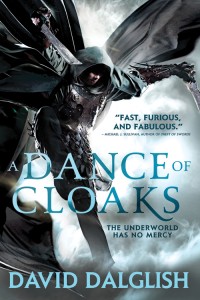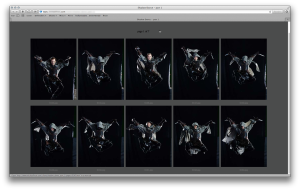The Making of a Cover: Rough Cuts

Welcome to the most in-depth, behind-the-scenes, play-by-play account of how a cover is born, from the point of view of the Art Department. We’re charting the conception and birth of the Shadowdance series by David Dalglish.
So far we have talked about the first real step of a book, Acquisition, and then what goes into Cover Briefing. Then we let our minds wander and collect inspiration and form Directions for the cover. Then we agreed on a Photographer and Illustrator. We’ve even found our hero, the Cover Model. And we found a Trampoline for him to do stunt work on safely. We decked him out in book-specific Costume & Props. We spent all day at our Photo Shoot. And then a few days later we got the Rough Cuts from the shoot.
Rough cuts are the raw images that the photographer shot, completely unedited. All the lighting tests and misfires are in there, so it’s a lot to go through. We were immediately thrilled at not only how much material we had to choose from, but also how amazing the quality of the images were. We knew we had way more than enough for six books. And I’ll let Kirk Benshoff tell you how he narrowed it down…
This is one of the most difficult and enjoyable parts of the process. Once the shoot was completed, I now have hundreds upon hundreds of pictures to comb through. In the days before digital, designers used to get contact/proof sheets from our photographers. A contact sheet is the process of developing film exactly the same size as the image on the negative. Contact sheets are ways to see entire rolls of film, so designers and editors can look at the shots and decide which images to use for the final project. Since the images are so small on a contact sheet, a loupe is used, which is a small magnifying lens to view the images in detail. Now with digital photography, we have programs that simulate the contact sheet for us on-screen.
One of the challenges back in those prehistoric days is we didn’t get our pictures right away. Shooting with film, you needed to wait a few days for the film to be developed, contact sheets made and finally shipped to your office. With digital photography, that wait time was virtually eliminated. In most cases I can leave a shoot with a hard drive of all the photographs. With the Shadowdance project, Michael Frost sent us a link to a special website he uses that acts as a virtual contact sheet. A hard drive with our high res images came the next day.
Looking at the images can be overwhelming at first. But once you divide up the pictures, it can be easier to handle. We group all of them by shots or pose and from there decide the best shot from each. Depending on how much post work/retouching you plan on doing, you may have images on the docket that you plan on taking elements from. For example, Image A is the best shot overall, but Image B the sword is in a better position and Image C The hood is sitting over the face nicer. So I’ll flag all of those shots and when I send everything to Gene Mollica, I’ll tell him about Image A, B, and C and he’ll do a new composite using the overall image from A but with the sword from B and the head/hood from C.
- Jumping Pose 1
- Jumping Pose 2
- Jumping Pose 3
- Jumping Pose 4
- Jumping Pose 5
- Jumping Pose 6
- Jumping Pose 7
In the case of these Shadowdance covers, we needed to immediately decide what poses were going to be on the first three books. So I brought in the best examples of my favorite poses and showed them in our cover meeting. As a group, which included my Publisher Tim Holman, Editor Devi Pillai, Creative Director Lauren Panepinto, and Marketing Alex Lencicki, we all debated in detail on which pose we felt best suited each volume of the series. Once we picked the overall best poses, then we really looked in-depth at which facial expressions, arm poses, leg poses, weapon shots were the most dynamic. With the magic of Photoshop and digital compositing, we can pick and choose the best bits of many photos and make them work together.
Once we decided on these, I sent Gene a huge email with lots of information and waited for his initial roughs on compositing all the best parts together.








